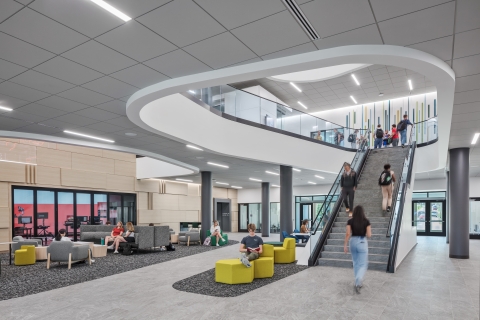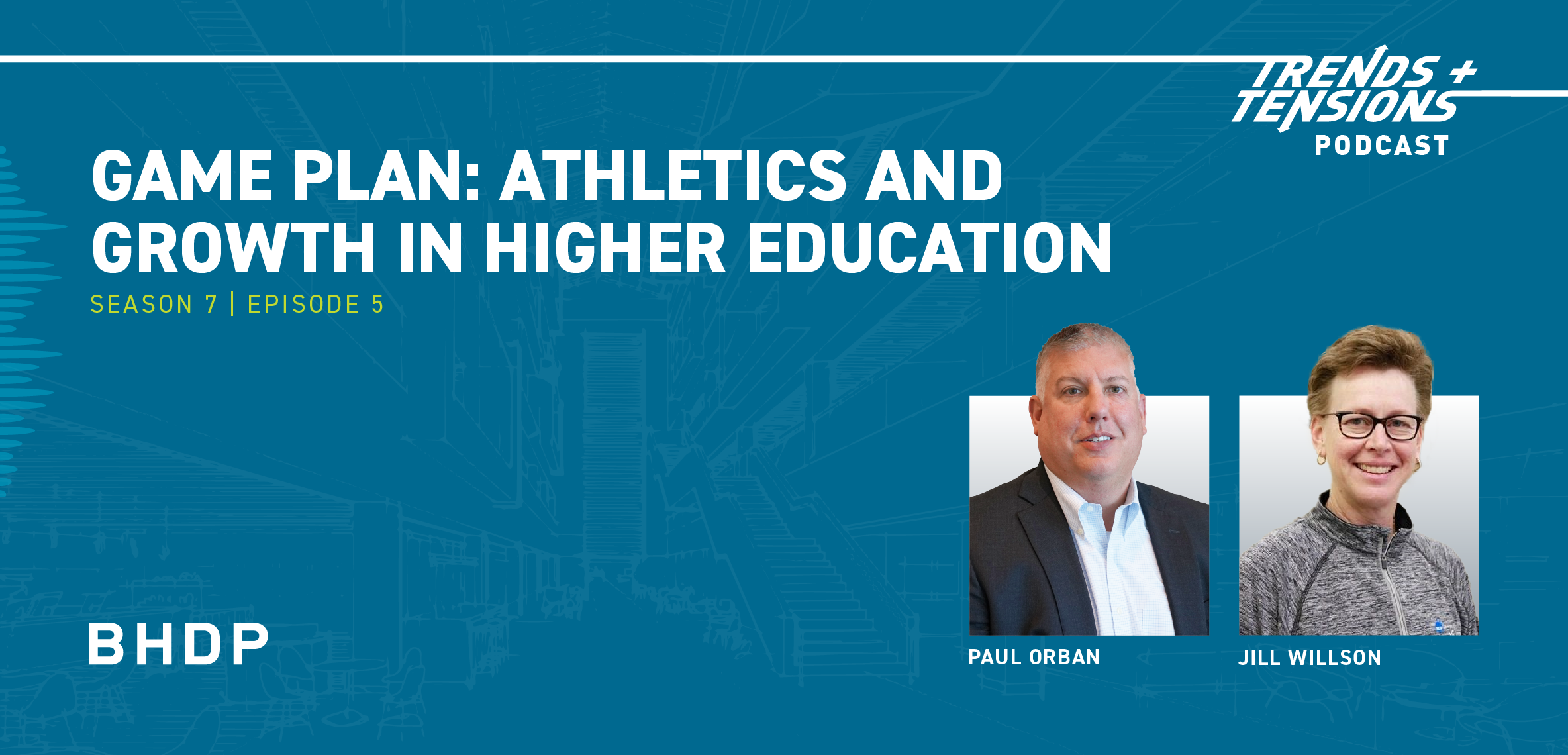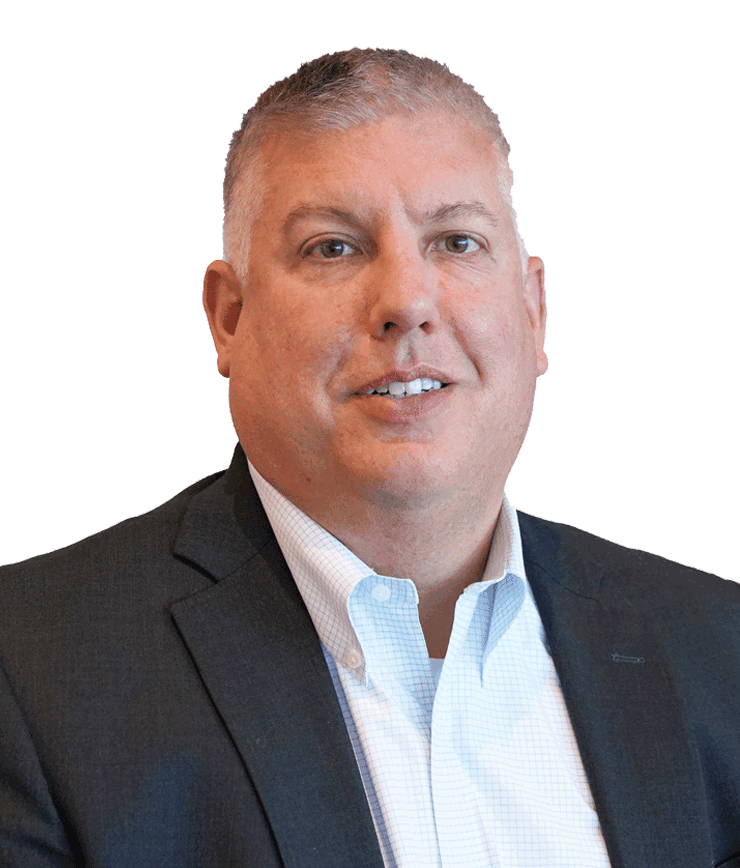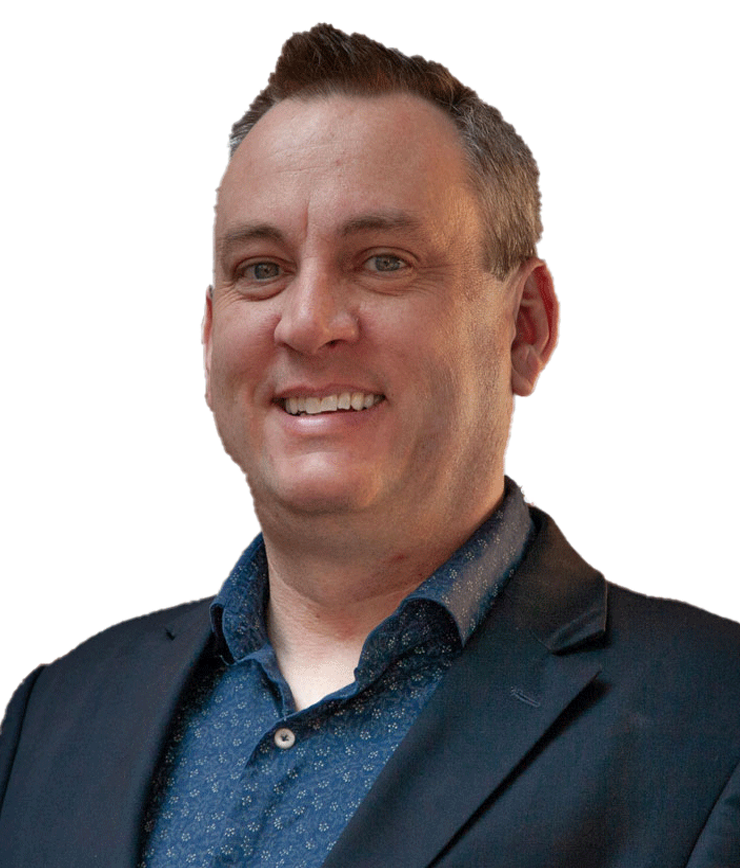
Game Plan: Athletics and Growth in Higher Education

Want to listen on another platform? Choose your platform here.
Episode Transcript
[Music Intro]
Brian Trainer, Host: Welcome to Trends + Tensions in Architecture and Design, presented by BHDP, where we discuss Trends in Architectural and Interior design and the competing priorities or Tensions that arise from integrating new ideas into existing organizations, enterprises, and institutions. In this episode, “Game Plan: Athletics and Growth in Higher Education,” we are joined by Jill Willson, Chief of Staff at Bethany College and President of Double L Consulting, along with Paul Orban, Managing Partner at BHDP. I am your host, Brian Trainer, senior strategist for BHDP. Let’s get started.
Brian: We are here today to talk about athletics and growth in higher education. Jill, tell us who you are and what you do.
Jill Willson: Thank you. I'm happy to join you all today on the call. My name is Jill Wilson. I was a former women's basketball coach and then athletic director at Texas A&M University-Kingsville before I started my own company in 2007. During that time, I started doing a little bit of work in the NCAA space in Division II. That was my first contract when I started my company. Since then, I have had five different contracts with the governance team at the NCAA, at the Division II level. But I also then started to diversify my business and to be able to help Division II and III schools with their job searches when they were looking for a new athletic director or compliance person, something like that. We would put a butt in the seat while we do the search so that those programs are not down manpower. Over the past couple of years, we've diversified even a little further and are helping colleges with their strategic plans, both at the conference level and at the individual institution level.
Brian: Very good. And Paul, would you remind listeners who you are?
Paul Orban: Yeah. Hello. I'm Paul Orban, the market leader for higher education, BHDP. I'm starting in my 25th year of architecture planning and strategy in the higher education space.
Brian: Since we wanna talk about athletics specifically in higher education. Jill, you're representing Bethany College right now. At least that's where you're sitting. Our first question is, how do independent colleges strategically prepare for athletics to enhance student experience and institutional growth?
Jill: Regardless of whether I'm sitting on Bethany College's campus in the beautiful Bethany, West Virginia, with lots of rolling hills, a beautiful creek that runs right behind the campus, as well as just tree-covered mountains. It is a beautiful place to be, but since 2007, I've been a part of helping schools leave the NAIA or Division III and come into Division II. In some ways, that was a way of using the partial scholarship model to increase enrollment. But I've also seen a significant number of colleges, especially at the Division III level, that have used athletics to grow their enrollment. Many times, the very best recruiters that you have on campus are your coaches. They can recruit a high number of student athletes to come and try to earn a spot on their rosters and be able to graduate within four years. And so here at Bethany College, as an example, when President Caridi got here four years ago, their enrollment was down, and they needed a way to increase enrollment.
And so, intentionally, Jamie gave each of the head coaches a roster minimum they had to meet and to try to get a roster maximum so they could have a good retention rate. And so really trying to juggle that space between what's a really good number that you can recruit and retain, versus how do you help with school, get out of debt by bringing a significant number of students to your campus, so that you can balance the budget or bring in more income. Every college president has to juggle those things. I really think there are very few schools in the country; I think I heard at one time, even, and now with name, image, and likeness, and some other challenges. I don't know that this is true, but at one time, there were only 16 Division I schools in the country that were actually able to operate in the black. Therefore, athletics is not an insignificant part of the budgets of colleges and universities. Using athletics as an enrollment management tool at a small, private faith-based institution like Bethany or a middle-of-the-road, Division I that's maybe really wanting to grow so that they can get better enrollment, more money to the campus, using athletics has been crucial for them.
Paul: So, as we're working with schools all over the country in terms of strategic planning for what's next on campus, it's the question that's coming up everywhere, right? Are people looking at what athletic programs they can either expand or add on campus? I would say that it's one of those top three issues that comes up every time we're working with a leadership group to start to talk about where are they growing and what does that look like, because it's the natural kind of growth path whether it's, hey, we have an existing program or we can add to that and grow it. What can we add to attract more students and have a new offering that will bring maybe a different group to campus, but also drive that enrollment increase?
Brian: I don't know what level of competition that you have. I'm looking at Paul here. I know he's a big fan of The Ohio State. When you're talking about athletics, comparing Ohio State to Bethany College, you have very different challenges with that operation. Does it make you more selective in the programs that you choose to support at your college? How do you make those decisions to try and stay competitive, to attract that enrollment, and keep that retention rate up?
Jill: I think Paul brings up a really good point. I think when he is visiting with clients, what is a good institutional fit to grow an institution? I think you have to be very intentional about that. In our strategic planning for Bethany College, one of the things that Jamie's been very intentional about is, what's around us? What do we have that we can use to our advantage? So, as an example, this past year, we just added a fly fishing club team. We just added women's flag football because we are in an area where flag football is of high interest. We already have a football field. We have a creek right behind us. We have equestrian because we have an equestrian field just directly up in Ogilby. And so what Bethany College has done is use what resources it has to be able to expand its offerings based on our surroundings, as well as what we think are our strengths.
And I think that's been very intentional by the institution, but that brings other challenges because we've to add additional staff now. We've gotta add additional trainers or sports information directors. So, it's not just. Adding athletes. We also have to think about the unintended consequences of what it means when we add more students to campus in a teaching load capacity and those class sizes, and maybe we will have to have more sections, which is fantastic, but also then what we can do to help the institution from a revenue generation standpoint.
Paul: Brian, I want to add to Jill's comment about some of those unique ads at Bethany. What I love about that is that when we're working with schools and leadership and talking about what we're doing in terms of campus planning and enhancements to help attract and retain students, we're often asking, what's unique about this place? What's memorable about this place? And what assets do you have? That you can leverage or optimize to get more out of. And what Bethany did there was their unique setting had some opportunity for, some unique athletics programs or student activities that were a natural in their setting and they knew based on their setting, the type of students that they may be trying to recruit would be looking for those types of activities or sports or programs while they're there. So, creativity and a strategic approach to leveraging one of your assets, rather than trying to add something new at a greater expense, is a great way to think about leveraging your campus and building upon what's already there.
Jill: When Paul was here doing our review of Bethany four years ago, we had eight tennis courts that were in significant disrepair. So we're going to power wash, clean, and seal up four of those and turn them into pickleball courts because now that's a popular sport. Repurposing some resources also gives us opportunities to expand our offerings to the students who attend Bethany College.
Brian: You added flag football because you have the football fields. You're gonna have pickleball because you have the tennis courts. What kind of creative repurposing are you looking for? Do you look for the program first, or do you have space? How do you decide which one? Hey, this would be a good fit for us because we can do this. Or is it, hey, can we do this, and do we have space for it?
Jill: Brian, that's a great question, and I think it's a combination of both. I think Jamie and I are always watching trends. So, if you would've asked me four years ago, what sport would you add? I would've said women's lacrosse, hands down. It is one of the fastest-growing sports in the NCAA. At that time, a significant number of young women wanted a place to play, and it was so different than this year when we look at it. Flag football in the NFL, looking at supporting this sport and putting some money behind it, helping the PAC conference, which Bethany College is a part of, to be a part of that expansion. So I think just watching, reading, and seeing what the trends are really matters. We couldn't have offered fly fishing as a club team if our Vice President and Dean of Students wasn't an excellent fly fisherman himself. I could teach fly fishing, but I'm not nearly as good as Jerry Stubbins. But because we had a vice president who was really good at teaching and being a great fly fisherman, he's taken on that responsibility. So, we just married some things that we had as strengths already to be able to help get more folks to come to Bethany College, in those two cases.
Brian: And you mentioned, though, that part of this is to increase enrollment. We want more students because that's where the money comes from. But with that, there's a strain on the infrastructure. So, what challenges have you had to face, such as deferred maintenance and campus planning? What other things arise when you are fortunate enough to grow that student population?
Paul: Brian, what I would say is one of the biggest pains right now is that we hear as we're working with new clients on getting through those early phases of a campus plan or understanding what the key issues are. This very positive growth through athletics has most often also caused some strain on facilities, not just for the athletic teams, but for the non-student athletes. So, it's very common right now, we're hearing. People need more locker room space. They need more athletic training space. Those programs are just overrun with the number of student-athletes they have. They're maxing out their capacity of training space, whether it's cardio or weights. The trickle-down effect is that the non-student athletes struggle to get any recreation time in a facility because we need to schedule those so much of the day to accommodate all the athletic programs. So, this whole idea about how you create space for student wellness, student wellbeing on campus recreation, cardio facilities, weight facilities, and so on, is that the student who isn't involved in athletics knows they can get in and use those.
As I mentioned earlier, the reason most athletic programs struggle with not having enough locker room space is that teams are seeing there's not enough time or space to get into athletic training facilities, and so on. So, it's just this snowball effect that, again, is a great thing on campus because we've driven growth and enrollment, but now it's growing pains attributable.
Jill: One of the things that I think Paul and I have discussed a number of times is that growing a university also gives the college or the university an opportunity to add additional programs. So, when you have additional money that comes to the college because of your growth in athletics, or what you're bringing in as revenue.
At Bethany College, we're about to add nursing in partnership with West Virginia Wesleyan, which means we've got to renovate a space where our old admissions office was into a SIM lab. Then, that means we need to renovate a couple of other classrooms to accommodate more people for more butts in the seats. As we add new majors that attract more non-student athletes, we need more teaching space. Sometimes, the unintended consequence of growing the athletic department also means adding additional programs and expanding other spaces in on-campus residence halls. Thank goodness we had an old residence hall that was closed down at Bethany College. So when we grew enrollment by 42%, the first year we were here, we had to spend a million dollars to renovate Harlan Hall just so we could have enough beds for all of the students. Some were student athletes, some weren't, but it was that growth and that revenue opportunity that allowed us to do that.
Brian: Yeah. What percent of your population are student athletes?
Jill: A little over 70%
Brian: Really? That's a significant number. It seems like it's a parallel challenge or opportunity. If you're increasing athletics but also increasing your programs, that population may grow. Is that the hope?
Jill: So happy you asked me that question, Brian, cause it's something that I definitely want to brag on. So, we intentionally used athletics in the first three years that we were here to increase enrollment at Bethany College. But this year, our new Vice President of Enrollment, Brian Sansom, has tripled the number of non-student athletes quickly because we've added new majors with our new provost, Danny Moore, and Brian working together. We've added new opportunities for general students to be attracted to Bethany College, and we have grown three times, just exponentially, in non-student athletes, thanks to those new programs and Danny and Brian's leadership
Brian: With the population growing and things changing, how do colleges like Bethany College ensure safe and well-maintained environments for athletes as programs evolve?
Jill: I'm gonna go backwards for a minute. In my life as a basketball coach, my practice time was my class time. It was important to me. So, I think we've all tried to work around a schedule where general student athletes have a blocked-out time when athletics are not allowed to have team practice in the weight room, for example. So, they don't have to worry about practicing with student athletes. They can be on treadmills or weight machines on their own. They can have access to that. And with our athletic facilities being limited to only having one gym, some of our teams are actually going some five thirty to seven thirty in the morning or from eight thirty to ten thirty at night so that there can be some open time.
I think it is just a matter of being extra organized in the things and the ways that you do your day-to-day operations to ensure that everybody has an opportunity to use the spaces in a safe way. I can't very well have open gym in the rec while our baseball team's hitting in the batting cages. I hope the baseballs stay in the batting cage, but I'm not gonna ensure that. I just want it to be safe. We have a scheduling system where we schedule all of our indoor and outdoor facilities to try to give each team its own designated time, as well as leaving opportunities for some of our open areas to be accessed by the general student body and/or faculty and staff. And Bethany's a very small town. We have a lot of alumni, boosters, and donors in town who come to our pool, who come to the weight room, and we love sharing our facilities with them as well.
Paul: These facilities are getting used very heavily. They're some of the most highly utilized spaces on campus, and they're obviously getting used in rough physical environments many of the time. So often when we're working with schools and we're looking at that deferred maintenance list there, there's quite a bit of this athletics-related space because track surfaces wear down, weight, equipment, it has a life to it, and those machines start to break down. So it's one of those clients that have to start planning for those maintenance and updates. Fortunately, athletics-related facilities are some of the easiest ones to fundraise for when it comes to renovations and improvements. And that's a benefit to this, but you still have to find that money, or you have to budget for that in the annual budget for renewal of space.
Otherwise, they just continue to take a beating and eventually become not even necessarily safe nor productive. Also, they're not helping you on the recruiting side, which is a whole other angle to this. We're seeing student-athletes constantly comparing the facilities to those of other institutions they have visited. Who has the better indoor facility? Who has the nicer weight room? It just goes on.
Brian: Jill, what partnerships have you created? We talked about the people who work with the institution. Do you have any external collaborations that are helping expand your athletic programs? What are you doing beyond the boundary of Bethany College?
Jill: Yeah, not just our athletic program. We recently signed a contractual agreement with a group called Smart Adventures, which is bringing international student athletes to Bethany, which has not always been the case for us. So, we have several students over the past year who have come from Nepal to join the Bethany family, and I think that's been fantastic from an athletic perspective. I think some of what we've been able to do with, as I mentioned earlier, the NFL. Working with the Pittsburgh Steelers, trying to figure out what the donation's going to be to the PAC Conference and what percentage of that may eventually come to us will matter. And so, I think, just using all kinds of resources around.
We are not only growing our facilities because, to Paul's point, we had an amazing donor who gave us a gift to renovate our weight room. And so we just finished that over a year ago. Man, has that brought some interest to campus. And so now, just looking at exactly to your point, can we start to charge for the rec center to be able to bring a little bit of revenue in? Can we go ahead and get the pool up and running so that we can have birthday parties and swim meets and things like that? But most importantly, I think it's our camps and clinics. I think our coaches are really developing a robust camp and clinics program because when little kids come to campus, they fall in love with the campus. If we could get kids to buy into the Bethany way of life early, then we'd get to recruit them the whole time they're in high school and hope that they come here as a collegiate athlete who matters. So, I think building that goodwill and better friendships when they're young really helps us later on. So we're really encouraging our coaches to try to get people to Bethany, whether it's just weekend camps and clinics or even summer camps and clinics.
Brian: So Jill, if you were advising higher education leaders today and their athletic program, which you do, as a matter of fact, what's your top recommendation for an athletic investment? Where should they start if they're trying to grow their program?
Jill: You need to be really strategic and really intentional. As you think about moving an athletic department forward, you have to think about what's best for the student-athletes because those are your customers. Those are in an athletic department setting. That's what we need to make sure that we can take care of. There's no sense in us adding an additional two or three hundred athletes if we're only going to get to have two trainers because their experience will be terrible. And so how you plan the number of sports that you offer, the number of sports that you're going to add, the additional staff members that you're going to have to bring on board, the limited facilities you have, and what can you repurpose or reuse, and how can you take an old gym and hurl and turn it into a beautiful wrestling arena. Which we did. It is absolutely fantastic over there. It was a building that, for the most part, sat empty, except for a few classes that were taught down there occasionally. Now it's an absolutely amazing wrestling facility. And now not only have we added women's wrestling, but we've added men's wrestling. And we'll bring about 30 additional kids to Bethany College next year through those two programs.
So, be thoughtful, be strategic, and then put your money where your mouth is. I think you have to know before you bite off more than you can chew, can we afford this, and can we afford not to do it? That's a question, too, just as important. Can we afford just to keep on doing things the way we've always done them? If we had done nothing at Bethany College four years ago to grow enrollment, this place would be closed, a hundred percent. But because we've been intentional about growth, strategic planning, and using our resources for the first time in 15 years, we will have balanced the budget. But that was all very strategic thinking and all very strategic planning. And so, does it cause pain? Yeah. It does, it causes pain. Change is hard, and this place has been very resistant to change over the years. But I think with the strategic initiatives and strategic planning, there's really been growth and change, and things are looking bright for Bethany College.
Brian: Paul, anything you'd like for listeners to take away from all this?
Paul: There's a great opportunity here to grow programs or add programs that positively impact enrollment. I think a low investment way to do this is to start with the right team that can help you assess programs and their capacity to grow or add in terms of enrollment, and at the same time assess the feasibility of how you would fold those into an existing campus plan or fabric. So, looking at how Jill has analyzed programs and seeing the actual number crunching behind the scenes, here's the capacity to add. If you add different sports, here's the startup cost. Here's the annual cost to impact a budget, but here's the plus side of enrollment. Now, how and where do we do that on campus? And figuring out that puzzle again, leverage maybe some assets you already have, instead of saying let's add baseball, and now we gotta build a baseball stadium.
Jill: Paul brings up a good point. Paul and I worked on another project together about a year ago with a small college in Missouri. They had mothballed a building that they were then going to be able to use to reopen and have some locker rooms as well as a wrestling facility to grow enrollment. Sometimes I think we get so busy being on our campus, until you have somebody who's outside eyes looking in and comes and does a review of what you have and what you could have. I think sometimes that jumpstarts some thinking because if you've been somewhere for a long time, it's hard for you to see what's right in front of you. If somebody from the outside comes in and takes a quick look, sometimes it's Oh my gosh, I hadn't thought about that. That's fantastic! We could have done that a while back. So, I think sometimes just having that extra set, like Paul said, the extra set of eyes, just to give you a jumping off point. You might not be able to do it all at the same time, but it might give you an opportunity to think freshly and get some fresh ideas about how other people across the country are doing things. I say that about my company all the time. My job is to copy and steal everything I can from one institution and share it with another.
I'm just a CASE manager. That's all it is. I'm copying and stealing everything I can get and sharing it with someone else. As a basketball coach, I never had an original play in my mind. I stole everyone from Pat, Gino, and Jody Conrad. I stole all of my basketball plays, whether that was inbounds, plays, offenses, or defenses. Now, as a contractor, I do the same on college campuses, copying and stealing the best ideas I see on one campus and bringing them to another. That's really ultimately what Paul and I try to do best for clients.
Brian: And maybe that's why it's a good idea to collaborate with somebody who's heard some of those ideas and knows what people are doing in other places. Jill, thank you so much for joining us today. Do you have any final thoughts you want to share with everyone?
Jill: It's an incredibly interesting time in college athletics. If there were ever a more interesting time, I don't know when it was, but I know that there are a lot of people out there who would sometimes find it easier to throw in the towel. I think your coaches are amazing recruiters, and I would urge you not to give up. Just hang in there. Let's get through this rough time, but continue to help your students and your student athletes have the best experience that they possibly can when they get to campus. And I think that matters cause higher education matters and it's hard. It's hard right now, but we can all do it for sure if we just hang in there together.
Brian: Jill, thank you very much. Thank you for sharing your expertise, Paul. Thank you, as always.
Paul: Thank you, Brian.
[Music Outro]
Brian Trainer, Host: Thank you for joining Trends + Tensions in Architecture and Design, presented by BHDP, for this episode, “Game Plan: Athletics and Growth in Higher Education,” with Jill Willson of Bethany College and Double L Consulting, along with Paul Orban of BHDP. If you appreciate what you have heard, please rate, subscribe, and give us a review. I am Brian Trainer, your host, and I hope you’ll join us for another episode of Trends + Tensions to see what topics drive design.
Author
Content Type
Podcast
Date
May 23, 2025
Market
Practice
Topic
Campus Planning
Athletics




